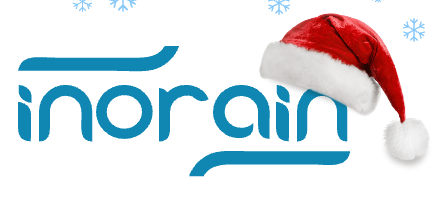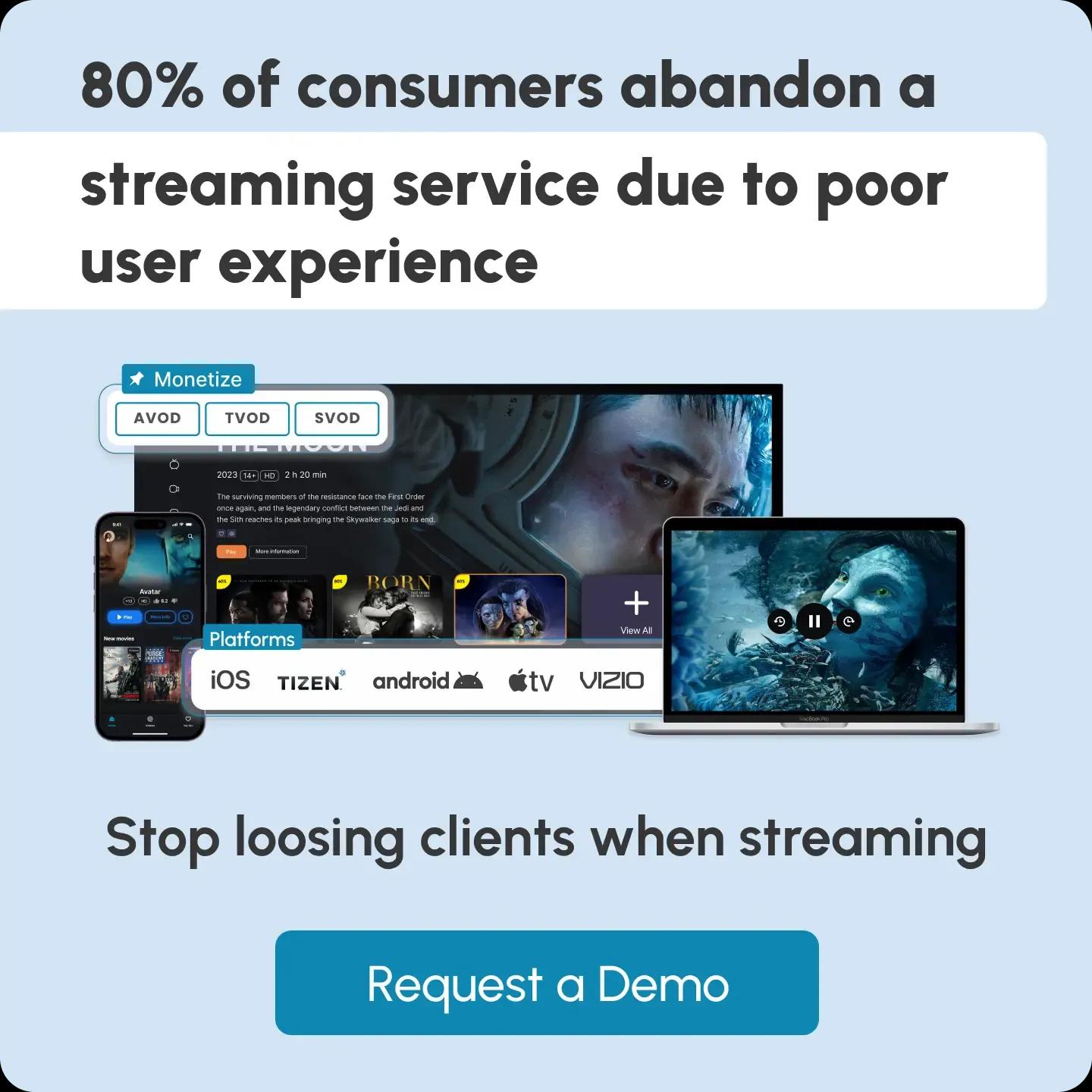
What Is Content Monetization? 7+ Proven Strategies for Success
“Your income is directly proportional to how well you serve your audience.” – Pat Flynn
To successfully monetize your content, you need to know your audience and gain insight, based on which you can plan effective strategies and offer them what they want. The key here is choosing the right monetization type, which, of course, depends on your target audiences’ preferences.
There are plenty of ways and strategies for monetizing your content. Depending on your target audience and business needs, you can choose the most suitable one.
If you’re unsure where to start, don’t worry - we’ve got you covered. In this article, you'll find everything about content monetization, explore practical strategies, and learn how to use them to your advantage.
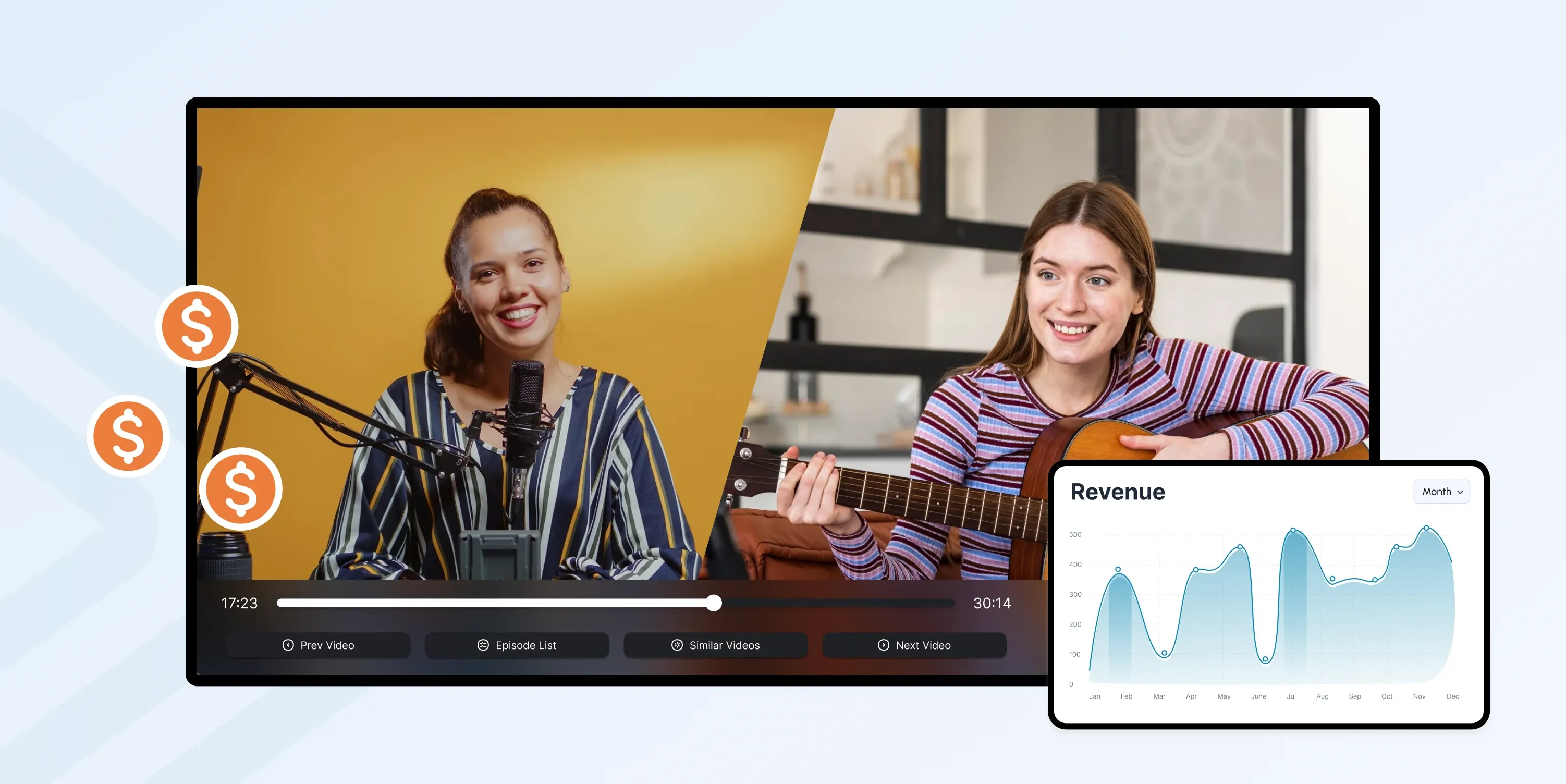
What Is Content Monetization?
Content monetization is the process of earning revenue from digital content (videos, blogs, podcasts, apps, etc.) through ads, subscriptions, paywalls, sponsorships, or other methods.
Visualize the process in 2 simple steps:
Step 1: You create the content and share it on the Internet (websites, channels, or social media).
Step 2: Your target audience views your ads or pays to access your content, and you make money.
Of course, the content monetization process involves more than just creating and sharing content and receiving money for it. You must identify your target audience, refine your content, and select the optimal monetization models and strategies.
Content Monetization Types
We’ve divided the content monetization into five main categories. In each category, you’ll discover more than three content monetization types.
1. Ad-Based Monetization (Indirect)
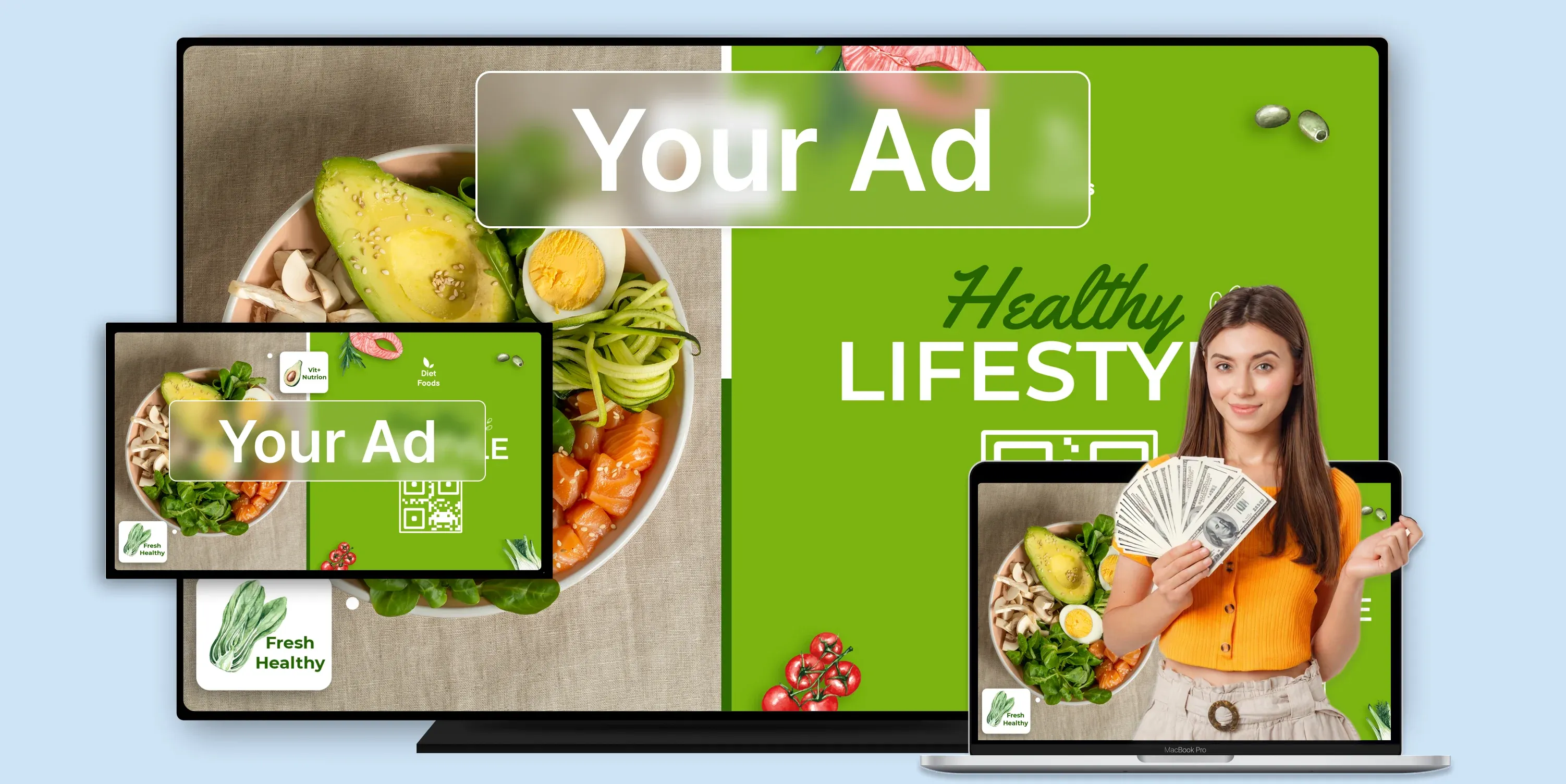 Ad-based monetization generates income from advertisers who want access to your audience. This includes:
Ad-based monetization generates income from advertisers who want access to your audience. This includes:
- Display ads like banners and pop-ups on websites
- Video ads such as pre-roll, mid-roll, and post-roll spots in streaming content
- Sponsorships and brand deals, where companies pay for dedicated promotions
- Affiliate marketing, which provides commissions when followers purchase products through your referral links
The advantage of this category is that it allows audiences to consume content for free while still generating revenue for the content owner; however, earnings are highly dependent on reach, engagement, and ad rates (CPM, CPC).
2. Direct-to-Consumer Monetization (Direct)
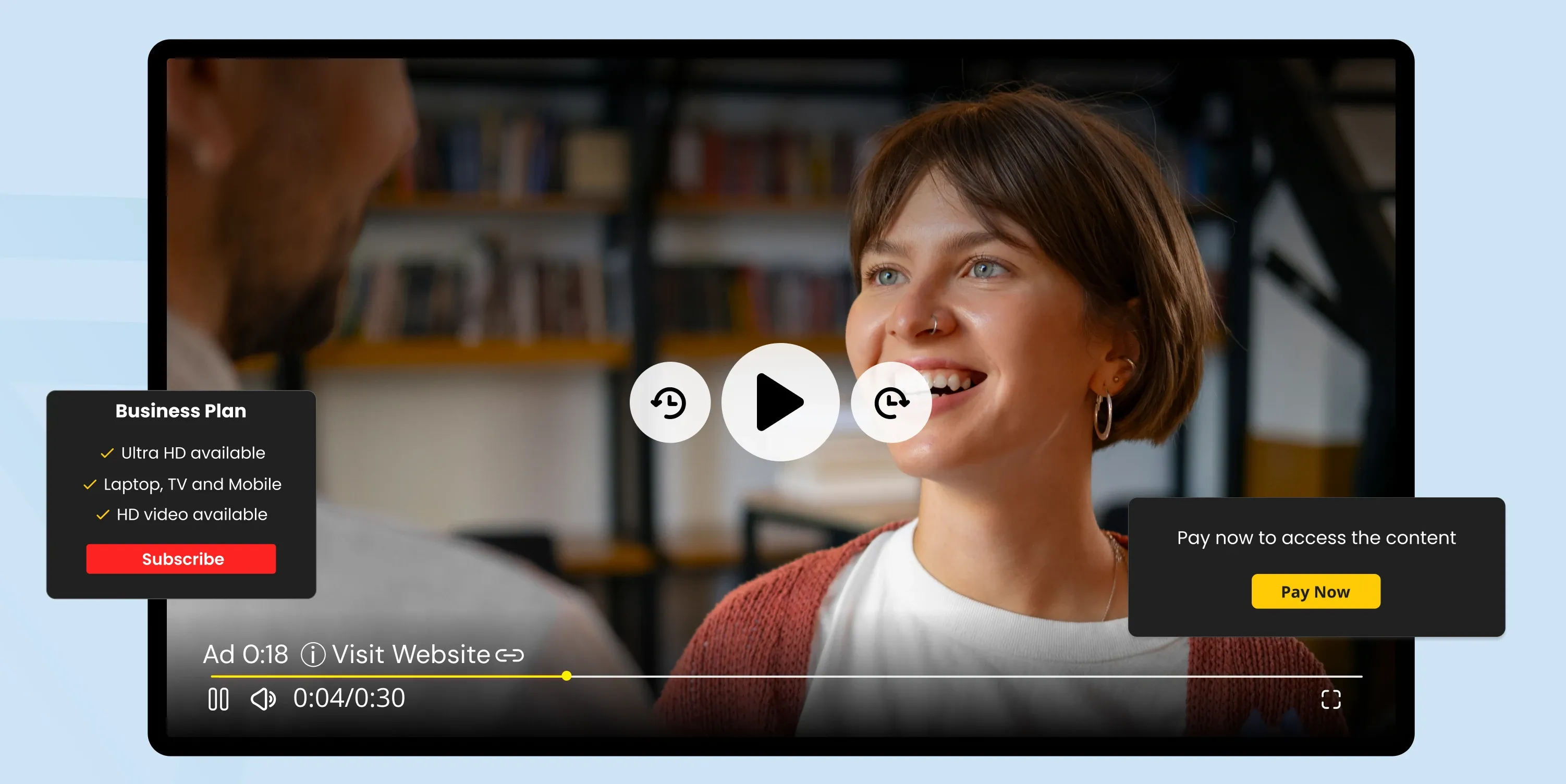 This model relies on revenue flowing straight from your audience. It includes:
This model relies on revenue flowing straight from your audience. It includes:
- Subscriptions and memberships (SVOD, Patreon, or exclusive fan clubs) provide a steady, recurring income in exchange for premium access
- Transactional or pay-per-view models (TVOD, one-time digital downloads, rentals) let viewers pay per piece of content without a long-term commitment
- Donations and tips give fans the chance to support creators directly, using tools like YouTube SuperChat, Twitch Bits, or Buy Me a Coffee
- Digital products and services such as e-books, online courses, templates, or branded merchandise
Direct-to-consumer content monetization fosters strong loyalty, but it requires a dedicated audience willing to pay for value-added content.
3. Licensing and Partnerships
 In this category, creators earn money by allowing third parties to distribute, resell, or rebrand their content. Here are the included monetization types:
In this category, creators earn money by allowing third parties to distribute, resell, or rebrand their content. Here are the included monetization types:
- Content licensing: Common in entertainment and media, where platforms like Netflix or Getty Images pay for usage rights
- Syndication: Involves distributing content across multiple outlets, such as a podcast being broadcast by multiple networks
- White-label and B2B partnerships: Allow companies to rebrand and resell content or technology solutions
Licensing and partnerships provide predictable, often large-scale revenue, but these usually require professional-quality production and legal agreements.
4. Platform-Specific Monetization
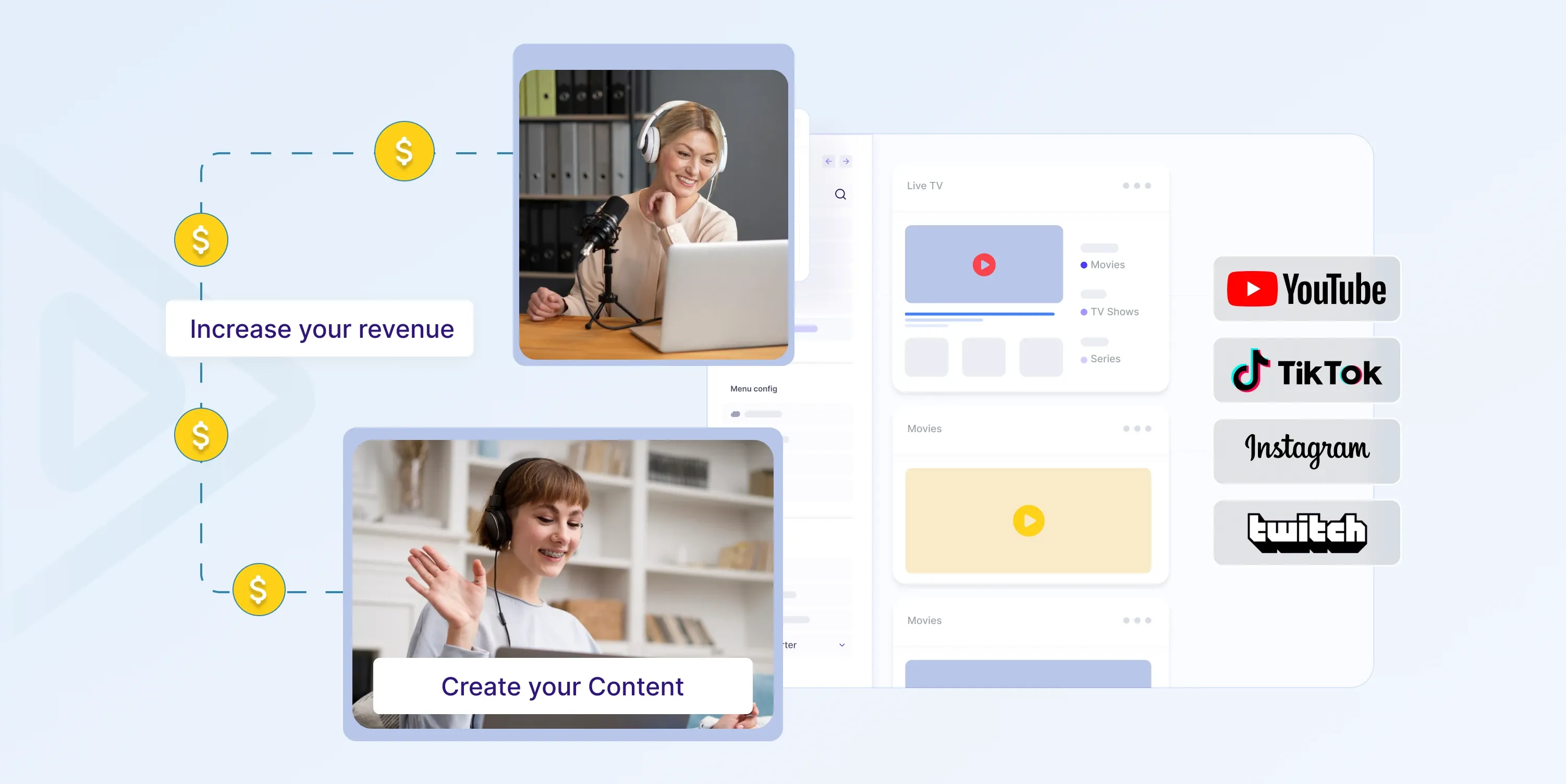 Many platforms offer built-in tools to help creators monetize without needing external systems. Here are some examples:
Many platforms offer built-in tools to help creators monetize without needing external systems. Here are some examples:
On YouTube, the Partner Program provides revenue from ads, memberships, SuperChats, and merchandise integration.
TikTok pays through its Creator Fund, TikTok Shop, or paywalled Series.
Instagram supports subscriptions, badges in live streams, and branded content deals.
Twitch creators can earn via subscriptions, Bits, ads, and fan donations.
The benefit of platform monetization is that it’s easy to set up and integrates directly into the platform ecosystem. Although the downside is revenue sharing, platforms often retain 30–50% of the earnings.
5. Hybrid and Emerging Models
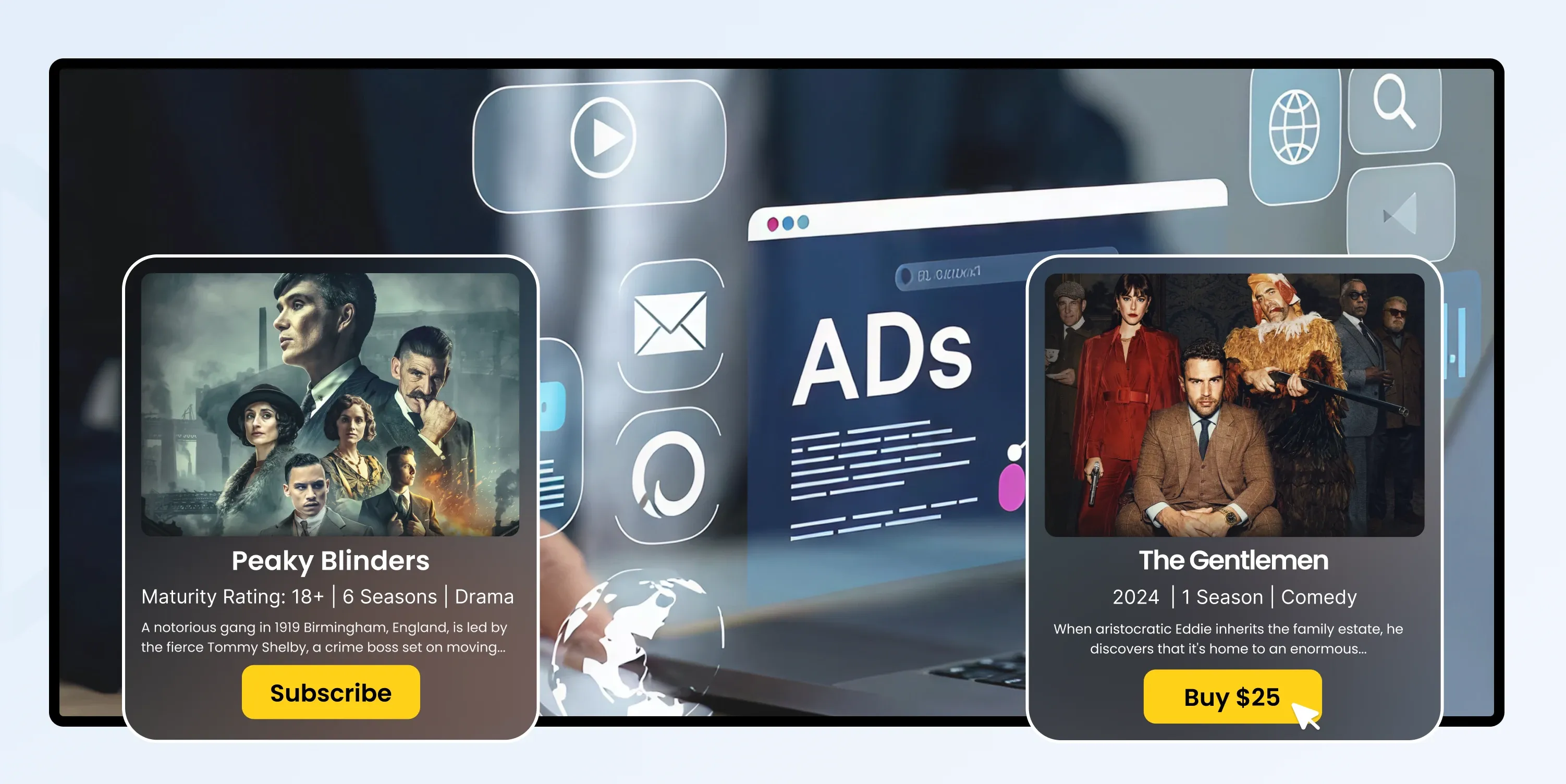 This category includes models that combine existing approaches or leverage new technologies.
This category includes models that combine existing approaches or leverage new technologies.
- Hybrid Video on Demand (HVOD) mixes ads with subscriptions, giving audiences lower prices while keeping ad revenue flowing.
- FAST channels (Free Ad-Supported Streaming TV) let viewers watch free, linear-like channels supported entirely by advertising - popular with OTT and streaming platforms.
- Freemium models combine free basic access with paid premium features, common in apps and games.
Emerging trends refer to NFTs, blockchain monetization, and microtransactions. These have the potential to reshape creator economies by allowing unique ownership, direct fan support, or gamified earning models.
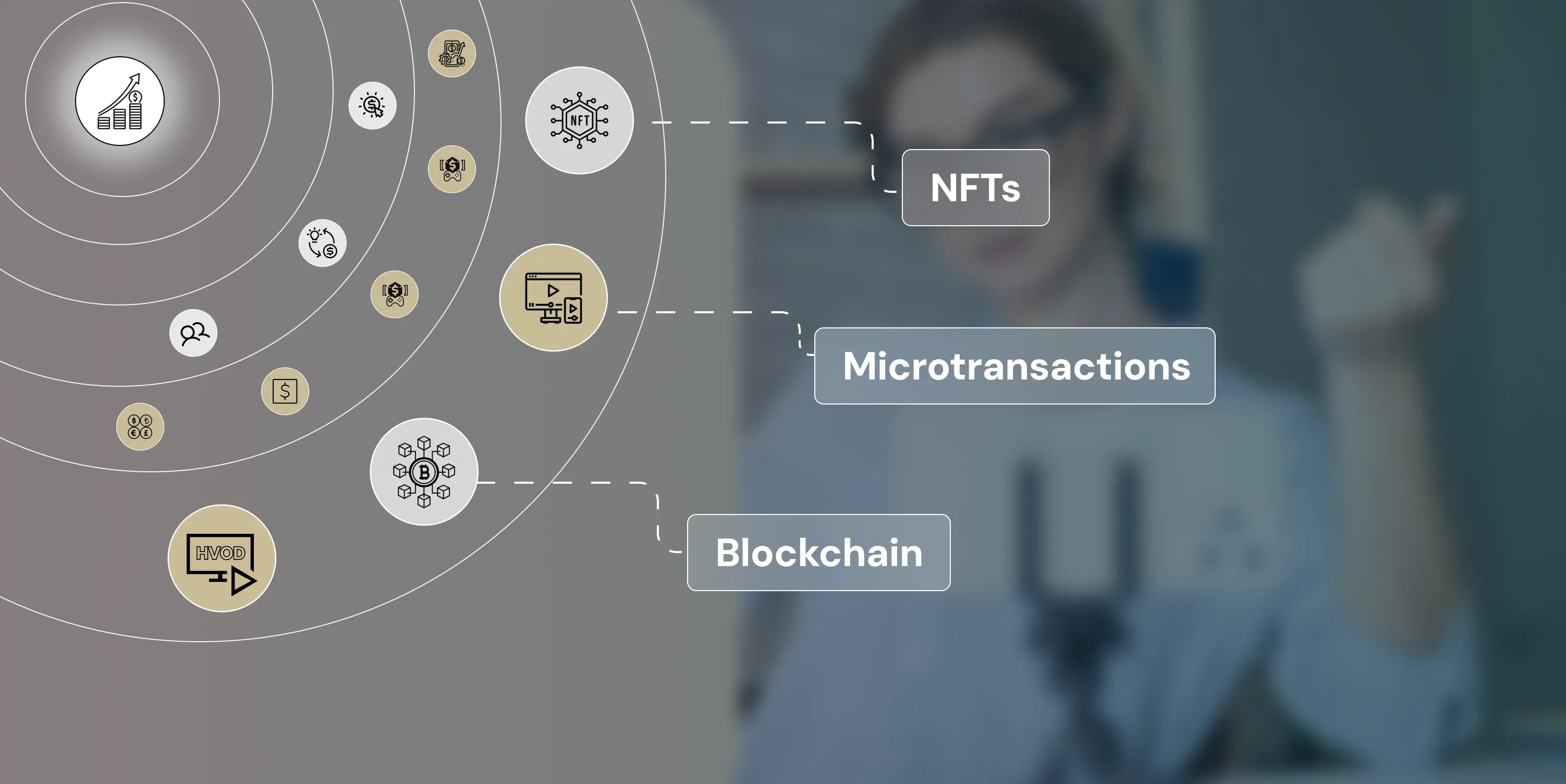 Let’s explore each separately.
Let’s explore each separately.
NFTs (Non-Fungible Tokens)
NFTs allow content creators to sell unique digital assets that represent ownership of content, such as art, music, videos, or exclusive access.
Unlike regular digital files, NFTs are stored on the blockchain, making them verifiable, secure, and rare. This rarity creates value for collectors and fans. For creators, NFTs can generate one-time sales and royalties from secondary resales, meaning income continues whenever the NFT is traded.
In the entertainment and media industries, NFTs can also unlock gated experiences, offer early access to releases, or provide membership perks.
Blockchain Monetization
Blockchain technology enables transparent, direct transactions between creators and audiences without having to rely on intermediaries like banks or platforms.
Blockchain payments can be made using cryptocurrencies, providing global access and faster transaction times. Smart contracts on blockchain ensure creators automatically get their share of revenue, royalties, or licensing fees.
Example: A song distributed on a blockchain-based platform can instantly split earnings between artists, producers, and collaborators.
Blockchain also supports decentralized streaming platforms, where revenue flows more directly to creators instead of being heavily shared with middlemen.
Microtransactions
Microtransactions are small payments made within content ecosystems, often used in gaming, apps, or interactive media.
Instead of charging a large upfront fee, creators earn by offering add-ons such as skins, filters, exclusive features, or premium interactions for a small additional cost. This model thrives on volume and repeat purchases - audiences pay in small amounts but frequently.
Outside of gaming, microtransactions are gaining popularity in live streaming (e.g., buying virtual gifts or badges for creators) and social platforms where fans pay to unlock premium reactions or interactions.
These approaches are mainly experimental but represent the future of digital content monetization.
11 Proven Content Monetization Strategies to Consider
Here are hand-picked monetization strategies that work perfectly if you’ve chosen them based on your audience preferences.
Subscription
Subscriptions in content monetization refer to a revenue model where users pay a recurring fee (monthly, quarterly, or annually) to access exclusive content, premium features, or an ad-free experience.
Subscription Models
1. SVOD (Subscription Video on Demand)
SVOD is one of the most common subscription models, especially in the streaming industry. The appeal lies in the "all-you-can-watch" format, with platforms like Netflix and Disney+ popularizing the model. SVOD’s main power lies in continuous content updates and personalized recommendations that keep users engaged. Its main challenge is churn - if content stops meeting expectations, users can cancel at any time.
2. Membership-Based Subscriptions
Membership models go beyond just content access. If you offer community features, special perks, or exclusive experiences, membership models are the best option.
Examples:
Netflix Premium Plan, which offers 4K Ultra HD streaming and the ability to watch on multiple devices simultaneously.
Spotify Premium, which provides ad-free listening, offline downloads, and unlimited skips compared to the free ad-supported tier.
Memberships work particularly well for niche creators, educators, or influencers who build strong, loyal communities.
3. Freemium Model
The freemium approach provides basic access for free, ad-supported, and limited features. To unlock the premium content with ad-free experiences and extra functionality, users have to pick a paid tier.
If your goal is to attract a broad user base, the freemium model is an ideal choice. It lowers entry barriers and then relies on upselling a portion of them into paid subscriptions. Here, your success depends on striking the right balance between free and premium value.
4. Hybrid Subscriptions (Ad + Paid Tiers)
Hybrid models combine ad-based monetization (discussed later) with subscriptions. Users can choose between a cheaper, ad-supported plan and a higher-priced, ad-free premium plan.
With this model, you can maximize your reach by catering to both price-sensitive users and those who prioritize convenience and uninterrupted experiences.
5. All-Access or Bundled Subscriptions
Bundling combines multiple services under one subscription to increase perceived value.
Examples:
Disney Bundle, which combines Disney+, Hulu, and ESPN+ under a single subscription at a discounted rate (compared to buying each separately).
Apple One which bundles Apple Music, Apple TV+, Apple Arcade, iCloud storage, Apple News+, and Apple Fitness+ into tiered subscription plans.
The best part about bundling is that it reduces subscription fatigue by giving users more value for a single payment. As a result, it helps minimize churn because users are less likely to cancel when multiple needs are met under a single plan.
Advertising
Advertising in content monetization is a revenue model where businesses, creators, or platforms earn income by allowing third-party ads to be displayed, streamed, or embedded alongside their content. Instead of charging users directly, the platform provides free or low-cost access and generates revenue from advertisers who pay to reach that audience.
Ad-based Monetization Models
6. Display Advertising
Display advertising is the most traditional and widely recognized format, consisting of visual ads such as banners, sidebars, and interstitials placed across websites, apps, or streaming interfaces.
These ads are typically sold on a CPM (cost per thousand impressions) or CPC (cost per click) basis. Therefore, their effectiveness depends on visibility, targeting, and placement.
While display ads can generate steady revenue, they are also prone to “banner blindness,” where users ignore them due to overexposure. So, when choosing display ads, always prioritize high personalization to attract user attention easily.
7. Advertising
Video ads have become a dominant force in digital monetization, especially with the growth of OTT platforms and social video content. They appear as:
- Pre-roll (before the main video)
- Mid-roll (during playback)
- Post-roll (after content)
Other variations include skippable ads, non-skippable ads, and rewarded video ads that users watch in exchange for perks, such as in gaming apps. Video ads are effective because they command user attention and allow for richer storytelling compared to static formats.
8. Native Advertising
Native advertising is designed to blend seamlessly into the platform’s content, making it feel less like a traditional ad and more like part of the user experience.
Examples:
Spotify Branded Playlists: Spotify works with brands like Nike to create curated playlists that users enjoy organically, while also promoting the brand’s identity and message.
Google Search Ads (Sponsored Results): Paid results appear at the top of searches but match the look of organic listings, marked only with “Sponsored.”
LEGO Movie: The entire film doubled as branded entertainment (native advertising at scale), delivering a story-driven experience that also boosted toy sales.
Because native ads match the look and feel of the environment, they tend to achieve higher engagement and trust, though transparency through clear labeling is crucial to maintain credibility.
9. Programmatic Advertising
Programmatic advertising uses automated, data-driven systems to buy and sell ad placements in real time. Platforms connect to ad exchanges, where advertisers bid on available impressions through real-time bidding (RTB).
Programmatic advertising ensures that users are served ads relevant to their demographics, behaviors, or browsing history.
Example:
Hulu sells ad space programmatically, letting advertisers use audience data to serve highly targeted video ads during streams. For instance, a sports apparel company can bid programmatically to ensure its ads appear during sports-related shows, thereby reaching a highly relevant audience without the need for manual negotiations.
With this model, you can increase efficiency and monetize inventory at scale. However, you may face ad fraud, reliance on third-party data, and ad quality problems.
10. Affiliate Advertising
Affiliate advertising focuses on performance-based revenue. Here, a publisher integrates ads, links, or banners that promote a third-party product or service, earning a commission when users complete an action such as a purchase or registration.
Example:
Amazon Associates is one of the largest affiliate programs in the world. Content creators and review sites place affiliate links to Amazon products. A tech blogger reviewing laptops may include affiliate links so readers can buy them directly on Amazon, earning the blogger a commission on each sale.
Unlike traditional display ads, affiliate ads tie income directly to conversions rather than impressions or clicks. This format will be effective for you if you’ve already earned highly engaged and loyal audiences who trust your recommendations.
11. Sponsored Content and Partnerships
Sponsored advertising involves direct deals with brands to feature their content in the form of articles, videos, or co-branded experiences.
Compared to programmatic or display ads, this format allows deeper storytelling and brand alignment.
Examples:
The New York Times and Netflix partnered to promote “Narcos”. The New York Times published an in-depth sponsored article on the history of cocaine trafficking. It looked like editorial journalism but was branded content designed to spark interest in the series.
Instagram Branded Partnerships: Fashion brands like Dior or Nike often collaborate with influencers to post content styled like regular posts, tagged with “Paid Partnership.” A fitness influencer might share a workout reel featuring Nike gear, blending content with brand promotion.
So, sponsored partnerships often yield higher payouts because they involve negotiation and exclusivity; however, they require a careful balance to maintain audience trust.
How to Start Content Monetization?
What do you need to start monetizing your content, other than having the content itself? Well, here are the three core steps you’ll take at the start of your content monetization journey.

Step 1. Find Your Target Audience
Your content should resonate with your audience (members, subscribers, followers). If you don’t connect with your audience, it will be difficult to capture their attention and earn their loyalty.
Focus on making your content relatable to increase its engagement. People are drawn to content they can connect with on a personal level. When your audience sees themselves reflected in your content, they engage and stay.
To ensure you're reaching the right audience, ask yourself key questions:
- Who is my ideal user?
- What do they need, and what motivates them?
- What problems are they facing, and how can I solve them?
- What type of content creators do they already follow?
Once you have attracted your target audience, you must retain them by consistently providing content that fulfills their interests and needs.
When your content is valuable and solves problems, it becomes more powerful and influential, helping you grow and expand your fanbase.
Step 2. Produce High-Quality and Unique Content
Have you heard of Mr. Beast? He is the world's biggest and most subscribed-to YouTuber.
Mr. Beast taps into the emotions and interests of his viewers, even involving them in his videos, which creates a strong connection. His ability to understand what his audience enjoys and what content drives the most engagement is key to his success.
The uniqueness of his videos makes them difficult to replicate, giving him a distinct advantage over other creators.
Mr. Beast’s content strategy is a perfect example of how high-quality and unique content can capture and retain audience attention, driving growth and engagement.
Step 3. Keep it Consistent
Without consistency, you cannot move forward and grow bigger. Consistency is not about posting every single day. It is about updating and adding original content to remind your audience that you’re still there, providing them with the solutions they need.
For starters, even one video per week or two videos per month can do the job. Your posting frequency will automatically increase once you get the hang of it.
Consistency allows for a higher rate of brand recognition, audience trust, growth, and algorithm favorability (in which your content would be pushed to more people).
How to Choose the Right Content Monetization Platforms?
Selecting the right content monetization platform can have a substantial impact on your revenue and audience reach. The best way to choose the right content monetization platform is to compare the available options and find the one that most caters to your target audience.
Here are the top content monetization platforms you can choose from.
Youtube
YouTube is the leader in video content. With its massive audience and versatile video formats - ranging from short-form content to in-depth videos - creators have endless opportunities to engage viewers.
Monetization Through
- YouTube Partner Program (YPP) - ad revenue share.
- Channel Memberships - recurring subscription fees.
- Super Chats & Super Stickers - fan donations during live streams.
- YouTube Premium Revenue - share of subscription revenue when Premium members watch content.
- Merch Shelf - sell branded merchandise directly below videos.
- Brand Sponsorships - paid promotions.
What’s Necessary to Start Monetizing on YouTube?
At least 500 subscribers + 3,000 watch hours in the past 12 months (for basic eligibility).
For ads: 1,000 subscribers + 4,000 watch hours OR 10M Shorts views in 90 days.
Must comply with YPP (YouTube Partner Program) policies.
Pros
- Largest video platform = huge audience potential
- Multiple revenue streams within one ecosystem
- Transparent analytics and payout system
Cons
- Strict eligibility and copyright rules
- YouTube keeps ~45% of ad revenue
- High competition; success often requires consistency + niche targeting
Tiktok
TikTok dominates the short-video space, allowing users to quickly capture the audience's attention with entertaining and engaging content.
TikTok is a hub for brand collaborations, with numerous companies leveraging creators for their advertising campaigns. So, you can use this to your advantage and increase your revenue.
Monetization Trough
- TikTok Creator Fund and Creativity Program - payouts based on views and engagement.
- TikTok Series - paywalled video collections.
- TikTok Live Gifts - fans send virtual gifts converted to cash.
- Brand Partnerships and Branded Content - sponsored posts, hashtag challenges.
- TikTok Shop and Affiliate - creators earn commission from product sales.
What’s Necessary to Start Monetizing on TikTok?
At least 10,000 followers + 100,000 video views in the last 30 days (for Creator Fund/Creativity Program).
You have to be 18+ years old and live in an eligible country.
Your content must follow community guidelines.
Pros
- Huge organic reach potential via the algorithm
- Multiple monetization tools (ads, gifts, shop)
- Strong brand partnership opportunities
Cons
- Creator Fund payouts are relatively low.
- Algorithm-driven visibility = income instability.
- Strict community guideline enforcement.
Facebook is one of the largest social platforms, offering creators multiple ways to share and monetize content - from videos and live streams to groups and events. Its global reach, paired with built-in monetization tools, makes it a powerful channel for building communities and generating revenue.
Monetization
Creators earn money through Facebook’s built-in monetization tools:
- In-stream ads (pre-roll, mid-roll in videos).
- Fan subscriptions (monthly recurring payments).
- Stars (virtual gifts purchased by fans).
- Paid Online Events (ticketed live events).
- Branded Content (partnering with advertisers).
- Facebook Reels Play Bonus (performance-based payouts, limited program).
What’s Necessary to Start Monetizing on Facebook?
At least 10,000 followers or 600,000 total minutes viewed in 60 days (for ads).
Follow Facebook’s Partner Monetization Policies and live in an eligible country.
Content must comply with community standards and copyright rules.
Pros
- Large global audience = big reach.
- Multiple monetization methods (ads, subs, brand deals).
- Easy setup with existing Facebook pages.
- Extra discovery via cross-posting to Instagram.
Cons
- Strict eligibility requirements.
- High competition; payouts can be low unless views are huge.
- The platform takes a revenue share.
- Algorithms change, affecting reach and income stability.
Instagram thrives as a visually driven platform, perfect for engaging audiences through photos, short videos, and stories. With features like Reels, subscriptions, branded content, and in-app shopping, it enables creators to grow their personal brand, connect with followers, and monetize through both direct fan support and brand partnerships.
Monetization
- In-stream Video Ads (IGTV ads) - share of ad revenue.
- Instagram Subscriptions - exclusive content for paying followers.
- Badges in Live - fans purchase badges during live streams.
- Branded Content - sponsored posts, brand partnerships.
- Affiliate and Shops - creators earn from product promotion and in-app shopping.
- Reels Bonus Program (limited rollout)
What’s Necessary to Start Monetizing on Instagram?
Must comply with Partner Monetization Policies.
Professional/creator account required.
Location eligibility varies by feature.
Need consistent engagement and original content.
Pros
- Direct access to brands for sponsorships.
- Multiple monetization tools (ads, shops, badges).
- Integrated with the Facebook ecosystem.
Cons
- High competition for brand deals.
- Some features are only available in select regions.
- Income is heavily tied to engagement metrics.
Twitch
Twitch is the leading platform for live streaming, especially in gaming, esports, and interactive entertainment. It offers creators a highly interactive environment to build loyal communities and monetize their streams effectively.
Monetization
- Subscriptions (Tiered) - monthly payments from viewers.
- Bits (Cheering) - virtual currency purchased by fans.
- Ads - pre-roll and mid-roll video ads.
- Donations - external platforms like PayPal or Streamlabs.
- Affiliate Marketing / Brand Deals - sponsored streams, partnerships.
What’s Necessary to Start Monetizing on Instagram?
It mainly depends on the program you choose.
Affiliate program: 50 followers + 500 minutes streamed in the last 30 days + 3 average viewers.
Partner program: higher requirements (large, consistent viewership).
And regardless of the program you have, you must comply with community guidelines.
Pros
- Strong community engagement with live audiences.
- Multiple fan-support features (subs, bits, donations).
- Brand deals are popular in gaming/esports.
Cons
- Earnings depend on viewer loyalty and live attendance.
- Twitch takes a 50% cut of subs (compared to lower rates on some platforms).
- Hard to grow without a consistent streaming schedule.
Content Monetization for OTT Services
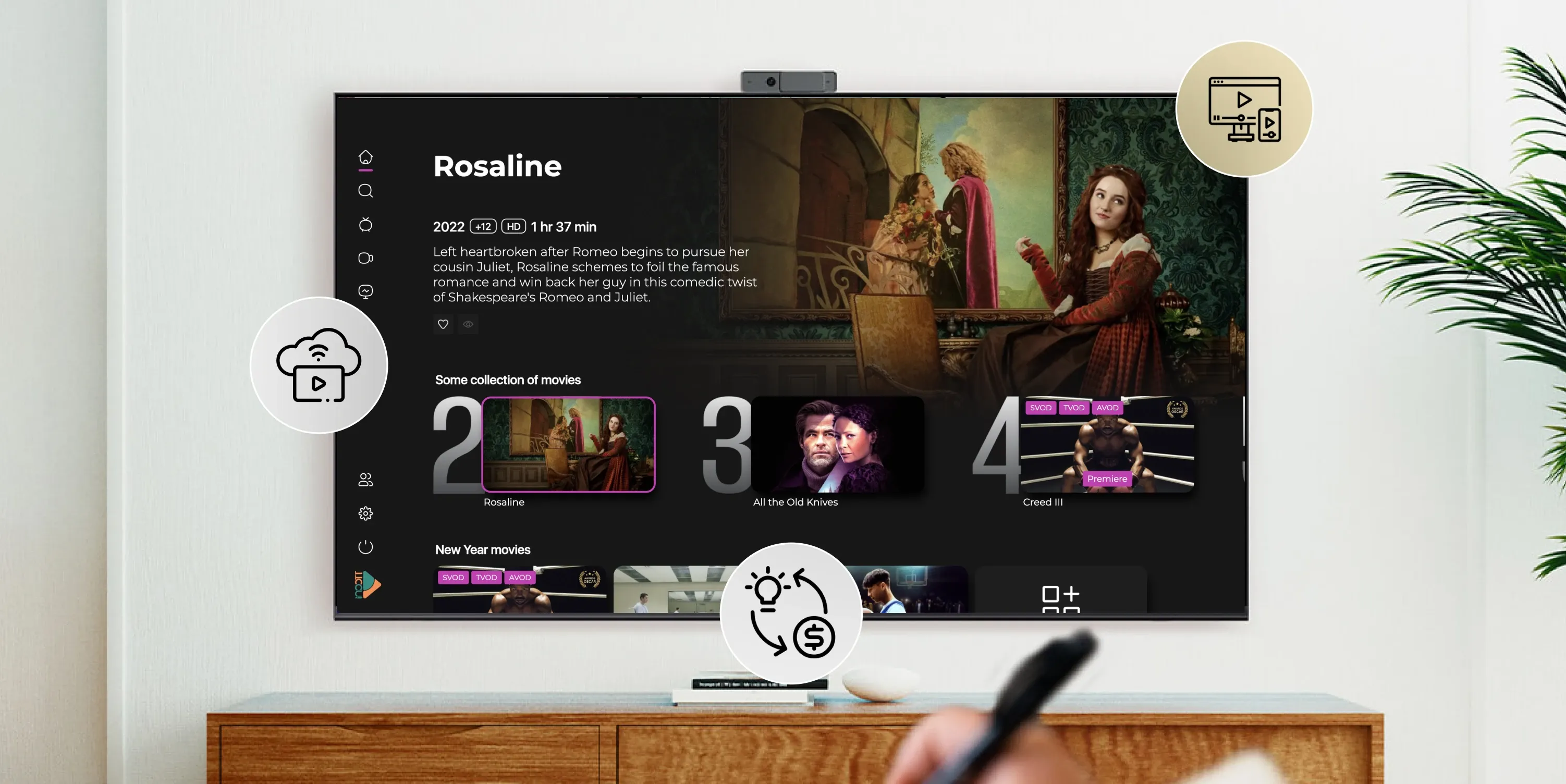 For beginners or creators unfamiliar with the technical side of things, content monetization may seem overwhelming. While the process is simple, it requires a solid understanding of content monetization policies and how to meet the necessary criteria.
For beginners or creators unfamiliar with the technical side of things, content monetization may seem overwhelming. While the process is simple, it requires a solid understanding of content monetization policies and how to meet the necessary criteria.
That’s where inoRain comes in, offering a complete solution to handle every aspect of content monetization - from content management to data analysis and the latest monetization techniques.
inoRain simplifies the process by allowing you to build your own OTT platform for streaming and content monetization. This level of customization will help you reach a larger audience, grow your follower base, and increase revenue.
We offer you 10+ monetization models, including SVOD, AVOD, TVOD, FAST, HVOD, and more. Just choose the best one for your streaming business needs and start monetizing your content on your own platform with your own rules.
In case of any questions, our support team is available 24/7.
Ready to Start Monetizing Your Content With Your Rules?
You've spent countless hours creating original, quality content. The next logical step is to ensure you're getting paid for your efforts. You know how to monetize your content; it’s time to take the plunge and start earning. Take the first step towards independent content monetization and get your own white-label OTT platform today. Manage, stream, and monetize your content from one centralized admin panel. Use your style, logo, and colors, and stand out to your target audience.
Ready to maximize your revenue? Partner with inoRain today and unlock your full monetization potential!
Frequently Asked Questions
Founder / CEO
Andranik is the CEO and Co-Founder of inoRain OTT and the Co-Founder of HotelSmarters, specializing in next-generation streaming technologies and digital transformation for the hospitality sector. He focuses on building innovative, scalable solutions for video delivery, OTT monetization, and data-driven hospitality management. His work bridges technical sophistication with practical business impact, helping organizations modernize their digital ecosystems and improve operational efficiency.

How to Develop a Video Streaming App: Best Practices
Learn the basics of developing a modern video streaming app. This guide covers key best practices to help you build the right way from the start.

How to Make a Short Video App (2026 Complete Guide)
Learn how to build a short video app in 2026. Explore micro-drama trends, key features, monetization models, and step-by-step development insights.

OTT Advertising: Types, Best Practices, and Strategies
Over-the-top (OTT) advertising has transformed how brands connect with consumers.
